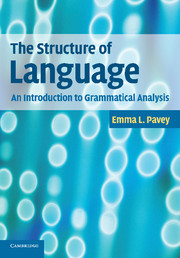Book contents
- Frontmatter
- Contents
- List of figures
- List of tables
- Acknowledgements
- Notes for instructors and readers
- List of abbreviations
- 1 Introduction
- 2 The structure of words
- 3 The structure of sentences
- 4 The structure of meaning
- 5 Integrating language structure
- 6 The structure of phrases
- 7 Complex structures
- 8 The structure of information
- 9 Language structure in context
- List of Languages
- Glossary
- Notes
- References
- Index
8 - The structure of information
Published online by Cambridge University Press: 05 June 2012
- Frontmatter
- Contents
- List of figures
- List of tables
- Acknowledgements
- Notes for instructors and readers
- List of abbreviations
- 1 Introduction
- 2 The structure of words
- 3 The structure of sentences
- 4 The structure of meaning
- 5 Integrating language structure
- 6 The structure of phrases
- 7 Complex structures
- 8 The structure of information
- 9 Language structure in context
- List of Languages
- Glossary
- Notes
- References
- Index
Summary
KEY TOPICS
Describing participants
Information structure in sentences
Focus types
Questions, commands and other sentence types
So far we have looked at morpho-syntactic structure and semantic meaning. The third aspect of language structure that we turn to now is information structure. When we think about language as a way of communicating, we need to think about how people choose to structure their utterances, based on what they know and what they think their hearer might already know.
Take a look at the sentences in (1). They all describe the same basic situation and have the same basic semantic content but would be used in different circumstances: describe the situations in which each one would be appropriate.
(1) (a) There is a spider on your back.
(b) It's a spider that's on your back.
(c) The spider, it's on your back.
(d) It's on your back.
(e) What's on your back is a spider.
Information structure terms and concepts
Before we discuss information structure in detail, this section deals with some key terminology.
Describing referents
When we talk about referents, we choose how to describe them based on a number of factors. One factor is how well our hearer knows the person we are talking about. Another factor is whether we have recently been talking about that person or not. Look at the sentences in (2) as examples.
All of the underlined noun phrases in (2) could refer to the same person. The description we chose would depend on the factors given above.
Information
- Type
- Chapter
- Information
- The Structure of LanguageAn Introduction to Grammatical Analysis, pp. 271 - 309Publisher: Cambridge University PressPrint publication year: 2010
